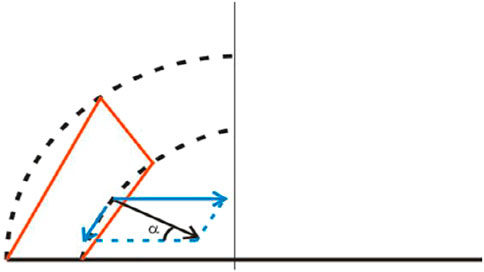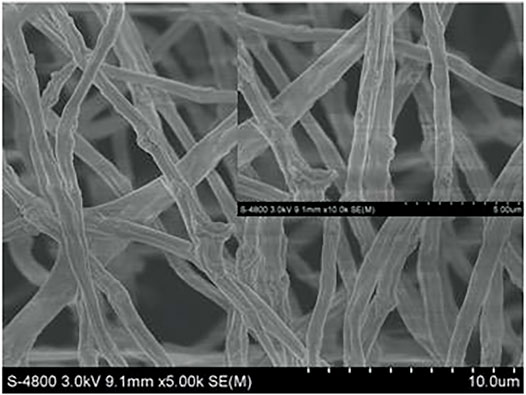- 1National Engineering Laboratory for Modern Silk, College of Textile and Clothing Engineering, Soochow University, Suzhou, China
- 2School of Mathematics and Information Science, Henan Polytechnic University, Jiaozuo, China
- 3Zhejiang Sci-Tech University, College of Textile Science and Engineering (International Silk College), Hangzhou, China
Polymer bubbles are ubiquitously used for the fabrication of nanofibers by the bubble electrospinning. When a bubble is broken, the fragments tend to be wrinkled. The wrinkle angle plays an important in controlling the fiber morphology during the bubble electrospinning. This paper shows the maximal angle is about 49°, which is close to the experimental value of 50°. This maximal angle can be used for the optimal design of the nozzle in the bubble electrospinning for the fabrication of non-smooth nanofibers.
Introduction
Bubble dynamics is an old discipline, and the Young-Laplace equation (Liu and Dou, 2013) is widely used for static analysis. The bubble’s rupture affects many materials’ fabricating processes (Zhang et al., 2021), especially for nanofiber fabrication by bubble electrospinning (Kong, 2015; Liu et al., 2020a; Li and He, 2020; Yin et al., 2020). When a bubble is broken, many jets are ejected, or many daughter bubbles are formed (Bird et al., 2010). Oratis et al. (2020) found the wrinkle mechanism of a liquid sheet during a bubble collapse, which has attracted skyrocketing attention from various fields, including mathematics and material science. Although this mechanism is new and has great promise, a mathematical model lacks for the prediction of the wrinkle angle. Here we establish a simple formula to study the wrinkle angle.
Maximal Wrinkle Angle
The bubble collapse and the wrinkle of the liquid sheet (Oratis et al., 2020) play an important role in the bubble electrospinning (Yin et al., 2020), Gratis et al. obtained an unparalleled achievement in the bubble collapse dynamics and found the surface tension drives the collapse and initiates its wrinkle (Oratis et al., 2020).
The surface tension depends upon the liquid sheet’s curvature radius, we assume that the initial surface tension is
From Eq. 1, it is obvious that the surface tension vanishes completely when the bubble is completely collapsed when
The force given in Eq. 1 can be decomposed into the radial and tangential forces, as shown in Figure 1, the former is the main force for collapse, and the latter is perpendicular to the section of the sheet, and it is the main force for liquid sheet’s instability, which leads finally to the wrinkle. According to Figure 1, the tangential force,
The maximal
That is
This equation can be solved by the ancient Chinese algorithm (He, 2016). We choose two angles
and
By the ancient Chinese algorithm (He, 2016), we have
The exact root of Eq. 4 is
When
Experiment
Bubble electrospinning was originally designed for the fabrication of smooth fibers (Liu et al., 2020b; Wan, 2020). In order to verify the theoretical prediction, we carried out an experiment where the angle between the solution surface and the bubble’s wall is about 49°, see Figure 2.
The spun solution was prepared by adding certain amounts of Lithium chloride (LiCl) dropwise to a 15 wt% Polyacrylonitrile/Polyethersulfone (PAN/PES) solution in N, N-Dimethylacetamide (DMAC) following with ultrasonic excitation agitating. The weight ratio of PAN and PES was controlled at 3/2, and the weight percentage of LiCl in the mixed solution was 1 wt%. Afterward, the PAN/PES/LiCl blend nanofibers were obtained using a high DC voltage power supply at a 20 kV potential and the collector with a distance of 15 cm from the bubble top. The SEM image of PAN/PES/LiCl nanofibers was presented in Figure 3. It is seen that we obtain the non-smooth fibers.
Discussion and Conclusion
This short paper gives a simple mathematical analysis, showing that the maximal wrinkle angle is about 49°, which is much closed to Oratis, et al.'s experimental value, which was about 50°. This angle can be used to design the nozzle angle in the bubble electrospinning; when wrinkled nanofibers are to be fabricated, the nozzle angle should be 49°. If smooth nanofibers are wanted, the nozzle angle should deviate from 49°.
Author Contributions
All authors listed have made a substantial, direct, and intellectual contribution to the work and approved it for publication.
Funding
The work was supported by Zhejiang Provincial Natural Science Foundation of China under Grant Nos. LQ21E030016, China Postdoctoral Science Foundation under Grant Nos. 2021M692866 and Program of Zhejiang Sci-Tech University (Grant Nos. 11110231281803). This research was also supported by “the Fundamental Research Funds of Zhejiang Sci-Tech University” (No. 2020Q002).
Conflict of Interest
The authors declare that the research was conducted in the absence of any commercial or financial relationships that could be construed as a potential conflict of interest.
Publisher’s Note
All claims expressed in this article are solely those of the authors and do not necessarily represent those of their affiliated organizations, or those of the publisher, the editors and the reviewers. Any product that may be evaluated in this article, or claim that may be made by its manufacturer, is not guaranteed or endorsed by the publisher.
References
Bird, J. C., de Ruiter, R., Courbin, L., and Stone, H. A. (2010). Daughter Bubble Cascades Produced by Folding of Ruptured Thin Films, Nature, 465, 759–762. doi:10.1038/nature09069
He, C.-H., Tian, D., Moatimid, G. M., Salman, H. F., and Zekry, M. H. (2021). Hybrid Rayleigh-van der pol-Duffing Oscillator: Stability analysis and controller. J. Low Freq. Noise, Vib. Active Control., 146134842110264. doi:10.1177/14613484211026407
He, C.-H. (2016). An Introduction to an Ancient Chinese Algorithm and its Modification. Int. J. Numer. Method. H. 26 (8), 2486–2491. doi:10.1108/hff-09-2015-0377
Khan, W. A. (2021). Numerical Simulation of Chun-Hui He's Iteration Method with Applications in Engineering. Int. J. Numer. Method. H. ahead-of-print. doi:10.1108/HFF-04-2021-0245
Kong, H. Y. (2015). Bubble Electrospinning and Nanofiber's Morphology Control and Applications. Soochow University. PhD thesis.
Li, X.-X., and He, J.-H. (2020). Bubble Electrospinning with an Auxiliary Electrode and an Auxiliary Air Flow, Nanotec, 14 (1), 42–45. doi:10.2174/1872210513666191107122528
Liu, F.-J., and Dou, H. (2013). A Modified Yang-Laplace Equation for the Bubble Electrospinning Considering the Effect of Humidity. Therm. Sci. 17 (2), 629–630. doi:10.2298/tsci121229028l
Liu, G.-L., Zhang, Y.-M., Tian, D., Zhou, B.-Z., Lu, Z.-Q., and Wang, C.-X. (2020). Last Patents on Bubble Electrospinning. Nanotec 14 (1), 5–9. doi:10.2174/1872210513666191107123446
Liu, G.-L., Zhang, Y.-M., Tian, D., Zhou, B.-Z., Lu, Z.-Q., and Wang, C.-X. (2020). Last Patents on Bubble Electrospinning. Nanotec 14 (1), 5–9. doi:10.2174/1872210513666191107123446
Oratis, A. T., Bush, J. W. M., Stone, H. A., and Bird, J. C. (2020). A New Wrinkle on Liquid Sheets: Turning the Mechanism of Viscous Bubble Collapse Upside Down. science 369, 685–688. doi:10.1126/science.aba0593
Wan, L. Y. (2020). Bubble Electrospinning and Bubble-Spun Nanofibers. Nanotec 14 (1), 10–13. doi:10.2174/1872210513666191007114022
Yin, J., Wang, Y., and Xu, L. (2020). Numerical Approach to High-Throughput of Nanofibers by a Modified Bubble-Electrospinning. Therm. Sci. 24 (4), 2367–2375. doi:10.2298/tsci2004367y
Zhang, Z. Y., Qiang, J., Wang, S. S., Xu, M., Gan, M., Rao, Z., et al. (2021). Visualization of Bubble Nucleation and Growth Confined in 2D Flakes. Small 17 (39), e2103301. Article 2103301. doi:10.1002/smll.202103301
Keywords: bubble, electrospinng, nanofiber, wrinkle, instability
Citation: He J-H, Qian M-Y and Li Y (2022) The Maximal Wrinkle Angle During the Bubble Collapse and Its Application to the Bubble Electrospinning. Front. Mater. 8:800567. doi: 10.3389/fmats.2021.800567
Received: 23 October 2021; Accepted: 21 December 2021;
Published: 03 February 2022.
Edited by:
Arjun Prasad Tiwari, Jeonbuk National University, South KoreaReviewed by:
Xin Jing, Hunan University of Technology, ChinaCopyright © 2022 He, Qian and Li. This is an open-access article distributed under the terms of the Creative Commons Attribution License (CC BY). The use, distribution or reproduction in other forums is permitted, provided the original author(s) and the copyright owner(s) are credited and that the original publication in this journal is cited, in accordance with accepted academic practice. No use, distribution or reproduction is permitted which does not comply with these terms.
*Correspondence: Ji-Huan He, aGVqaWh1YW5Ac3VkYS5lZHUuY24=; Ya Li, bGl5YUB6c3R1LmVkdS5jbg==
 Ji-Huan He
Ji-Huan He Man-Yu Qian
Man-Yu Qian Ya Li
Ya Li

